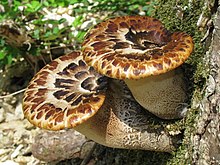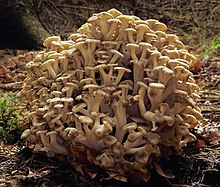Polyporaceae
| Polyporaceae | |
|---|---|

| |
| Dryad's saddle (Cerioporus squamosus) | |
| Scientific classification | |
| Domain: | Eukaryota |
| Kingdom: | Fungi |
| Division: | Basidiomycota |
| Class: | Agaricomycetes |
| Order: | Polyporales |
| Family: | Polyporaceae Fr. ex Corda (1839)[1] |
| Type genus | |
Adans. (1763)
| |
| Synonyms[2] | |
| |
The Polyporaceae (Polyporus badius.
Most of these fungi have white
Cystidia
are absent.
Taxonomy
In his 1838 work Epicrisis Systematis Mycologici seu Synopsis Hymenomycetum,
Genera


Hapalopilus nidulans




As of April 2018[update], Index Fungorum accepts 114 genera and 1621 species in the Polyporaceae:[11]
- Abundisporus Ryvarden (1999);[12] 7 species
- Amyloporia Singer (1944);[13] 5 species
- Amyloporiella A.David & Tortič (1984); 1 species
- Atroporus Ryvarden (1973); 3 species
- Aurantiporus Murrill (1905);[14] 5 species
- Australoporus P.K.Buchanan & Ryvarden (1988);[15] 1 species
- Austrolentinus Ryvarden (1991);[16] 1 species
- Cellulariella Zmitr. & Malysheva (2014); 2 species
- Cerrena Gray (1821); 7 species
- Cerarioporia F.Wu, L.W.Zhou & Jing Si;[17] 1 species
- Colospora Miettinen & Spirin (2015);[18] 1 species
- Coriolopsis Murrill (1905); 21 species
- Crassisporus B.K. Cui & Xing Ji (2019); 4 species
- Cryptomphalina R.Heim (1966);[19] 1 species
- Cryptoporus (Peck) Shear (1902); 2 species
- Cystidiophorus Bondartsev & Ljub. (1963);[20] 1 species
- Daedaleopsis J.Schröt. (1888); 9 species
- Datronia Donk (1966); 8 species
- Datroniella B.K.Cui, Hai J.Li & Y.C.Dai (2014); 5 species
- Dentocorticium (Parmasto) M.J.Larsen & Gilb. (1974); 7 species
- Dextrinoporus H.S.Yuan (2018);[21] 1 species
- Dichomitus D.A.Reid (1965); 24 species
- Diplomitoporus Domański (1970); 20 species
- Earliella Murrill (1905); 1 species
- Echinochaete D.A.Reid (1963); 5 species
- Epithele (Pat.) Pat. (1900); 24 species
- Epithelopsis Jülich (1976); 2 species
- Erastia Niemelä & Kinnunen (2005); 1 species
- Faerberia Pouzar (1981); 1 species
- Favolus Fr. (1828); 25 species
- Flammeopellis Y.C.Dai, B.K.Cui & C.L.Zhao (2014);[22] 1 species
- Fomes (Fr.) Fr. (1849); 59 species
- Funalia Pat. (1900); 7 species
- Fuscocerrena Ryvarden (1982); 1 species
- Globifomes Murrill (1904); 1 species
- Grammothele Berk. & M.A.Curtis (1868); 19 species
- Grammothelopsis Jülich (1982); 7 species
- Hapalopilus P.Karst. (1881); 15 species
- Haploporus Bondartsev & Singer (1944); 6 species
- Hexagonia Fr. (1836); 41 species
- Hymenogramme Mont. & Berk. (1844); 1 species
- Laccocephalum McAlpine & Tepper (1895); 5 species
- Laetifomes T.Hatt. (2001); 1 species
- Leifiporia Y.C.Dai, F.Wu & C.L.Zhao (2016);[23] 2 species
- Leiotrametes Welti & Courtec. (2012); 2 species
- Lentinus Fr. (1825); 120 species
- Lenzites Fr. (1836); 25 species
- Leptoporus Quél. (1886); 12 species
- Lignosus Lloyd ex Torrend (1920); 8 species
- Lithopolyporales R.K.Kar, N.Sharma, A.Agarwal & R.Kar (2003); 1 species
- Lloydella Bres. (1901); 3 species
- Lopharia Kalchbr. & MacOwan (1881); 15 species
- Loweporus J.E.Wright (1976); 8 species
- Macrohyporia I.Johans. & Ryvarden (1979); 3 species
- Megasporia B.K.Cui, Y.C.Dai & Hai J.Li (2013);[24] 7 species
- Megasporoporia Ryvarden & J.E.Wright (1982); 4 species[25]
- Megasporoporiella B.K.Cui, Y.C.Dai & Hai J.Li (2013);[24] 5 species
- Melanoderma B.K.Cui & Y.C.Dai (2011); 2 species
- Melanoporella Murrill (1907); 1 species
- Microporellus Murrill (1905); 23 species
- Microporus P.Beauv. (1805); 12 species
- Mollicarpus Ginns (1984); 1 species[26]
- Mycobonia Pat. (1894); 1 species
- Myriothele Nakasone (2013);[27] 1 species
- Navisporus Ryvarden (1980); 6 species[28]
- Neodatronia B.K.Cui, Hai J.Li & Y.C.Dai (2014); 2 species[29]
- Neodictyopus Palacio, Robledo, Reck & Drechsler-Santos; 3 species[30]
- Neofavolus Sotome & T.Hatt. (2013); 4 species[31]
- Neofomitella Y.C.Dai, Hai J.Li & Vlasák (2015); 3 species
- Nigrofomes Murrill (1904); 2 species
- Pachykytospora Kotl. & Pouzar (1963); 3 species[32]
- Panus Fr. (1838); 40 species
- Perenniporia Murrill (1942); 100 species
- Perenniporiella Decock & Ryvarden (2003); 5 species
- Perenniporiopsis C.L.Zhao (2017); 1 species[33]
- Phaeotrametes Lloyd ex J.E.Wright (1966); 1 species
- Piloporia Niemelä (1982); 2 species
- Podofomes Pouzar (1966); 3 species
- Polyporus P.Micheli ex Adans. (1763); 279 species
- Porogramme (Pat.) Pat. (1900); 7 species
- Poronidulus Murrill (1904); 2 species
- Pseudofavolus Pat. (1900); 6 species
- Pseudopiptoporus Ryvarden (1980); 2 species[28]
- Pseudomegasporoporia 1 species[34]
- Pycnoporus P.Karst. (1881); 4 species
- Pyrofomes Kotl. & Pouzar (1964); 7 species
- Roseofavolus T.Hatt. (2003);[35] 1 species
- Royoporus A.B.De (1996); 2 species[36]
- Rubroporus Log.-Leite, Ryvarden & Groposo (2002); 2 species[37]
- Ryvardenia Rajchenb. (1994); 2 species[38]
- Sarcoporia P.Karst. (1894); 3 species
- Skeletocutis Kotl. & Pouzar (1958); 43 species
- Sparsitubus L.W.Hsu & J.D.Zhao (1980); 1 species[39]
- Spongipellis Pat. (1887); 9 species
- Stiptophyllum Ryvarden (1973); 1 species[40]
- Thermophymatospora Udagawa, Awao & Abdullah (1986); 1 species
- Tinctoporellus Ryvarden (1979); 4 species[41]
- Trametes Fr. (1836); 195 species
- Trametopsis Tomšovský (2008); 1 species[42]
- Tyromyces P.Karst. (1881); 119 species
- Truncospora Pilát (1953); 10 species
- Vanderbylia D.A.Reid (1973); 7 species[43]
- Wolfiporia Ryvarden & Gilb. (1984); 6 species[44]
- Xerotus Fr. (1828); 16 species
- Yuchengia B.K.Cui & Steffen (2013);[45] 1 species
In a proposed family-level classification of the Polyporales based on
Dendrodontia, Dentocorticium, Dichomitus, Donkioporia, Earliella, Echinochaete, Epithele, Favolus, Fomes, Fomitella, Ganoderma, Grammothele, Grammothelopsis, Hexagonia, Haploporus, Hornodermoporus, Lentinus, Lignosus, Lopharia, Megasporia, Megasporoporia, Melanoderma, Microporellus, Microporus, Neodatronia, Neofavolus, Pachykytospora, Perenniporia, Perenniporiella, Pseudofavolus, Pyrofomes, Tinctoporellus, Tomophagus, Trametes, Truncospora, Vanderbylia, and Yuchengia.[2]
References
- ^ a b Corda, A.C.J. (1839). Icones fungorum hucusque cognitorum. Vol. 3. p. 49.
- ^ PMID 28800851.
- ^ Fries, E. M. (1838). Epicrisis Systematis Mycologici: Seu Synopsis Hymenomycetum [A Critical Study of Mycology: A Synopsis of the Hymenomycetes] (in Latin). Vol. 1–2. Uppsala, Sweden: Regiae Academiae Typographia. p. 408.
- ^ For example:
- Murrill, William A. (1902). "The Polyporaceae of North America. I. The genus Ganoderma". Bulletin of the Torrey Botanical Club. 29 (10): 599–608. JSTOR 2478682.
- Murrill, William A. (1903). "The Polyporaceae of North America. II. The genus Pyropolyporus". Bulletin of the Torrey Botanical Club. 30 (2): 109–120. JSTOR 2478882.
- Murrill, William A. (1903). "The Polyporaceae of North America.-III. The genus Fomes". Bulletin of the Torrey Botanical Club. 30 (4): 225–232. JSTOR 2478780.
- Murrill, William A. (1903). "The Polyporaceae of North America.-IV. The genus Elfvingia". Bulletin of the Torrey Botanical Club. 30 (5): 296–301. JSTOR 2478555.
- Murrill, William A. (1903). "The Polyporaceae of North America.-V. The genera Cryptoporus, Piptoporus, Scutiger and Porodiscus". Bulletin of the Torrey Botanical Club. 30 (8): 423–434. JSTOR 2478728.
- Murrill, William A. (1904). "The Polyporaceae of North America-VI. The genus Polyporus". Bulletin of the Torrey Botanical Club. 31 (1): 29–44. JSTOR 2478751.
- Murrill, William A. (1904). "The Polyporaceae of North America-VII. The genera Hexagona, Grifola, Romellia, Coltricia and Coltriciella". Bulletin of the Torrey Botanical Club. 31 (6): 325–348. JSTOR 2478798.
- Murrill, William A. (1904). "The Polyporaceae of North America-VIII. Hapalopilus, Pycnoporus, and new monotypic genera". Bulletin of the Torrey Botanical Club. 31 (8): 415–428. JSTOR 2478892.
- Murrill, William A. (1904). "The Polyporaceae of North America-IX. Inonotus, Sesia and monotypic genera". Bulletin of the Torrey Botanical Club. 31 (11): 593–610. JSTOR 2478612.
- Murrill, William A. (1905). "The Polyporaceae of North America-X. Agaricus, Lenzites, Cerrena, and Favolus". Bulletin of the Torrey Botanical Club. 32 (2): 83–103. JSTOR 2478510.
- Murrill, William A. (1905). "The Polyporaceae of North America-XI. A synopsis of the brown pileate species". Bulletin of the Torrey Botanical Club. 32 (7): 353–371. JSTOR 2478499.
- Murrill, William A. (1905). "The Polyporaceae of North America-XII. A synopsis of the white and bright-colored pileate species". Bulletin of the Torrey Botanical Club. 32 (9): 469–493. JSTOR 2478463.
- Murrill, William A. (1905). "The Polyporaceae of North America-XIII. The described species of Bjerkandera, Trametes, and Coriolus". Bulletin of the Torrey Botanical Club. 32 (12): 633–656. JSTOR 2478704.
- Murrill, William A. (1907). "North American flora 9. Part 1". New York: The New York Botanical Garden.
{{cite journal}}: Cite journal requires|journal=(help) - Murrill, William A. (1908). "North American flora 9. Part 2". New York: The New York Botanical Garden.
{{cite journal}}: Cite journal requires|journal=(help) - Murrill, William A. (1905). "The Polyporaceae of North America: XII. A synopsis of the white and bright-colored pileate species". Bulletin of the Torrey Botanical Club. 32 (9): 469–494. JSTOR 2478463.
- Murrill, William A. (1902). "The Polyporaceae of North America. I. The genus Ganoderma". Bulletin of the Torrey Botanical Club. 29 (10): 599–608.
- JSTOR 3756376.
- ^ Bondartsev, A.S. (1953). The Polyporaceae of the European USSR and Caucasia. Moscow: Israel Program for Scientific Translations.
- ^ Donk, M.A. (1960). "The generic names proposed for Polyporaceae". Persoonia. 1 (2): 173–302.
- ^ Donk, M.A. (1964). "A conspectus of the families of Aphyllophorales". Persoonia. 3 (2): 199–324.
- ^ Cunningham, G.H. (1965). "Polyporaceae of New Zealand". New Zealand Department of Scientific and Industrial Research Bulletin. 164: 1–304.
- ^ Pegler, D.N. (1973). "Aphyllophorales IV. Poroid families". In Ainsworth, G.C.; Sparrow, F.K.; Sussaman, A.S. (eds.). The Fungi IV-B an advance treatise. Vol. IV B. New York and London: Academic press. pp. 397–420.
- ^ Kirk, P.M. "Species Fungorum (version 28th March 2018). In: Species 2000 & ITIS Catalogue of Life". Archived from the original on 27 November 2020. Retrieved 9 April 2018.
- ^ Ryvarden, Leif (1998). "African polypores: A review". Belgian Journal of Botany. 131: 150–155.
- JSTOR 3754880.
- JSTOR 2478463.
- ^ Buchanan, P.K.; Ryvarden, L. (1988). "Type studies in the Polyporaceae – 18. Species described by G.H. Cunningham". Mycotaxon. 31 (1): 1–38.
- ISBN 978-8290724103.
- .
- S2CID 62809402.
- ^ Heim, R. (1966). "Breves diagnoses latinae novitatum genericarum specificarumque nuper descriptarum". Revue de Mycologie. 30: 231–241.
- ^ Bondartsev, A.; Ljubarsky, L.V. (1963). "Genus novum et species novae Polyporacearum in Oriente extremo inventae". Botanicheskie Materialy Otdela Sporovyh Rastenij Botanicheskogo Instituti Imeni V.L. Komarova. 16: 125–133.
- S2CID 46980180.
- S2CID 15028386.
- S2CID 16171473.
- ^ S2CID 27669415.
- ^ Ryvarden, L.; Wright, J.E.; Rajchenberg, M. (1982). "Megasporoporia, a new genus of resupinate polypores". Mycotaxon. 16 (1): 172–182.
- ^ Ginns, J. (1984). "Mollicarpus gen. nov. (Polyporaceae) with notes on Coriolopsis byrsina, Phellinus crocatus, and Polystictus crocatus var. sibiricus". Mycotaxon. 19: 71–80.
- ^ Nakasone, K.K. (2013). "Taxonomy of Epithele (Polyporales, Basidiomycota)". Sydowia. 65: 59–112.
- ^ a b Ryvarden, Leif; Johansen, I. "A preliminary polypore flora of East Africa". Oslo: Fungiflora: 443, 523.
{{cite journal}}: Cite journal requires|journal=(help) - PMID 25264389.
- PMID 29049417.
- S2CID 11066884.
- ^ Kotlába, F.; Pouzar, Z. (1963). "A new genus of the Polypores –Pachykytospora gen. nov". Ceská Mykologie. 17 (1): 27–34.
- S2CID 90297945.
- .
- S2CID 86230358.
- ^ De, A.B. (1996). "Royoporus – a new genus for Favolus spathulatus". Mycotaxon. 60: 143–148.
- ^ Loguercio-Leite, Clarice; Ryvarden, Leif; Groposo, Claudia (2002). "Studies in neotropical polypores 16. Rubroporus carneoporis genus & species nova". Mycotaxon. 83: 223–227.
- .
- ^ Xu, L.W.; Zhao, J.D. (1980). "[A new genus of Polyporaceae from China]. Acta Microbiologica Sinica" (in Chinese). 20: 236–239.
{{cite journal}}: Cite journal requires|journal=(help) - ^ Ryvarden, L. (1973). "New genera in the Polyporaceae". Norwegian Journal of Botany. 20 (1): 1–5.
- .
- .
- ^ Reid, D.A. (1973). "A reappraisal of type and authentic specimens of Basidiomycetes in the van der Byl herbarium, Stellenbosch". South African Journal of Botany. 39 (2): 141–178.
- ^ Ginns, J. (1984). "New names, new combinations and new synonymy in the Corticiaceae, Hymenochaetaceae and Polyporaceae". Mycotaxon. 21: 325–333.
- .
